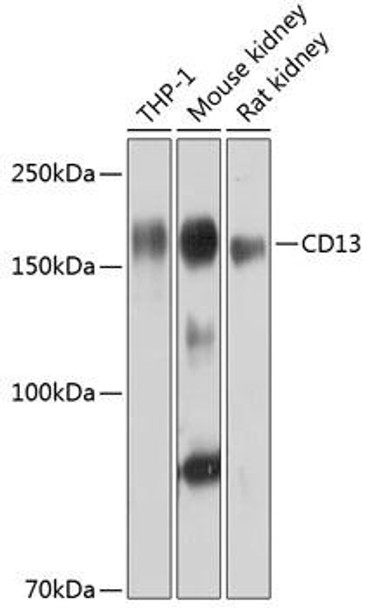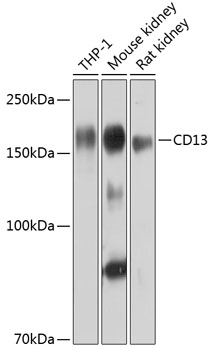Anti-CD13 Antibody (CAB11669)
- SKU:
- CAB11669
- Product type:
- Antibody
- Reactivity:
- Human
- Reactivity:
- Mouse
- Reactivity:
- Rat
- Host Species:
- Rabbit
- Isotype:
- IgG
- Antibody Type:
- Monoclonal Antibody
- Research Area:
- Cardiovascular
Frequently bought together:
Description
| 抗体名: | Anti-CD13 Antibody |
| 抗体コード: | CAB11669 |
| 抗体サイズ: | 20uL, 50uL, 100uL |
| 申し込み: | WB IHC IF |
| 反応性: | Human, Mouse, Rat |
| 宿主種: | Rabbit |
| 免疫原: | A synthesized peptide derived from human CD13 |
| 申し込み: | WB IHC IF |
| 推奨希釈: | WB 1:500 - 1:2000 IHC 1:50 - 1:200 IF 1:50 - 1:200 |
| 反応性: | Human, Mouse, Rat |
| ポジティブサンプル: | THP-1, Mouse kidney, Rat kidney |
| 免疫原: | A synthesized peptide derived from human CD13 |
| 精製方法: | Affinity purification |
| ストレージバッファ: | Store at -20°C. Avoid freeze / thaw cycles. Buffer: PBS with 0.02% sodium azide, 0.05% BSA, 50% glycerol, pH7.3. |
| アイソタイプ: | IgG |
| 順序: | Email for sequence |
| 遺伝子ID: | 290 |
| Uniprot: | P15144 |
| セルラーロケーション: | Cell membrane, Cytoplasm, Single-pass type II membrane protein, cytosol |
| 計算された分子量: | 110kDa |
| 観察された分子量: | 160KDa |
| 同義語: | APN, CD13, GP150, LAP1, P150, PEPN |
| バックグラウンド: | Aminopeptidase N is located in the small-intestinal and renal microvillar membrane, and also in other plasma membranes. In the small intestine aminopeptidase N plays a role in the final digestion of peptides generated from hydrolysis of proteins by gastric and pancreatic proteases. Its function in proximal tubular epithelial cells and other cell types is less clear. The large extracellular carboxyterminal domain contains a pentapeptide consensus sequence characteristic of members of the zinc-binding metalloproteinase superfamily. Sequence comparisons with known enzymes of this class showed that CD13 and aminopeptidase N are identical. The latter enzyme was thought to be involved in the metabolism of regulatory peptides by diverse cell types, including small intestinal and renal tubular epithelial cells, macrophages, granulocytes, and synaptic membranes from the CNS. Human aminopeptidase N is a receptor for one strain of human coronavirus that is an important cause of upper respiratory tract infections. Defects in this gene appear to be a cause of various types of leukemia or lymphoma. [provided by RefSeq, Jul 2008] |
| UniProt Protein Function: | CD13: Broad specificity aminopeptidase. Plays a role in the final digestion of peptides generated from hydrolysis of proteins by gastric and pancreatic proteases. May play a critical role in the pathogenesis of cholesterol gallstone disease. May be involved in the metabolism of regulatory peptides of diverse cell types including small intestinal and tubular epithelial cells, macrophages, granulocytes and synaptic membranes from the CNS. Found to cleave antigen peptides bound to major histocompatibility complex class II molecules of presenting cells and to degrade neurotransmitters at synaptic junctions. Is also implicated as a regulator of IL-8 bioavailability in the endometrium, and therefore may contribute to the regulation of angiogenesis. Is used as a marker for acute myeloid leukemia and plays a role in tumor invasion. In case of human coronavirus 229E (HCoV-229E) infection, serves as receptor for HCoV-229E spike glycoprotein. Mediates as well human cytomegalovirus (HCMV) infection. Belongs to the peptidase M1 family. |
| UniProt Protein Details: | Protein type:EC 3.4.11.2; Membrane protein, integral; Other Amino Acids Metabolism - glutathione; Protease; Receptor, misc. Chromosomal Location of Human Ortholog: 15q26.1 Cellular Component: ER-Golgi intermediate compartment; extracellular space; integral to plasma membrane; lysosomal membrane Molecular Function:aminopeptidase activity; metallopeptidase activity; peptide binding; receptor activity; zinc ion binding Biological Process: peptide catabolic process |
| NCBI Summary: | Aminopeptidase N is located in the small-intestinal and renal microvillar membrane, and also in other plasma membranes. In the small intestine aminopeptidase N plays a role in the final digestion of peptides generated from hydrolysis of proteins by gastric and pancreatic proteases. Its function in proximal tubular epithelial cells and other cell types is less clear. The large extracellular carboxyterminal domain contains a pentapeptide consensus sequence characteristic of members of the zinc-binding metalloproteinase superfamily. Sequence comparisons with known enzymes of this class showed that CD13 and aminopeptidase N are identical. The latter enzyme was thought to be involved in the metabolism of regulatory peptides by diverse cell types, including small intestinal and renal tubular epithelial cells, macrophages, granulocytes, and synaptic membranes from the CNS. Human aminopeptidase N is a receptor for one strain of human coronavirus that is an important cause of upper respiratory tract infections. Defects in this gene appear to be a cause of various types of leukemia or lymphoma. [provided by RefSeq, Jul 2008] |
| UniProt Code: | P15144 |
| NCBI GenInfo Identifier: | 143811362 |
| NCBI Gene ID: | 290 |
| NCBI Accession: | P15144.4 |
| UniProt Secondary Accession: | P15144,Q16728, Q6GT90, Q8IUK3, Q8IVH3, Q9UCE0, |
| UniProt Related Accession: | P15144 |
| Molecular Weight: | |
| NCBI Full Name: | Aminopeptidase N |
| NCBI Synonym Full Names: | alanyl aminopeptidase, membrane |
| NCBI Official Symbol: | ANPEP |
| NCBI Official Synonym Symbols: | APN; CD13; LAP1; P150; PEPN; GP150 |
| NCBI Protein Information: | aminopeptidase N |
| UniProt Protein Name: | Aminopeptidase N |
| UniProt Synonym Protein Names: | Alanyl aminopeptidase; Aminopeptidase M; AP-M; Microsomal aminopeptidase; Myeloid plasma membrane glycoprotein CD13; gp150; CD_antigen: CD13 |
| UniProt Gene Name: | ANPEP |


